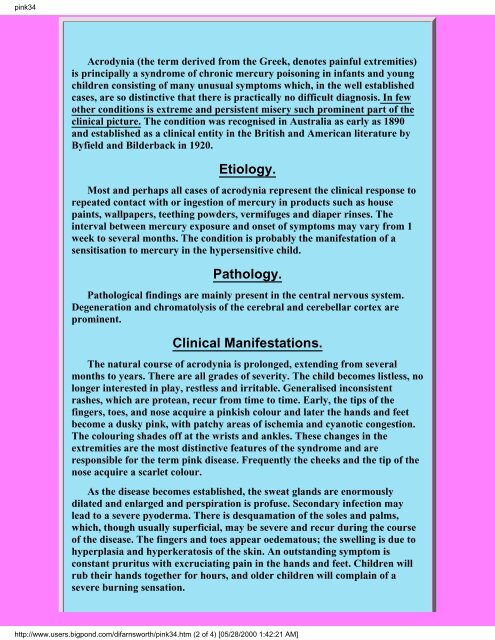You also want an ePaper? Increase the reach of your titles
YUMPU automatically turns print PDFs into web optimized ePapers that Google loves.
pink34Acrodynia (the term derived from the Greek, denotes painful extremities)is principally a syndrome of chronic mercury poisoning in infants and youngchildren consisting of many unusual symptoms which, in the well establishedcases, are so distinctive that there is practically no difficult diagnosis. In fewother conditions is extreme and persistent misery such prominent part of theclinical picture. The condition was recognised in Australia as early as 1890and established as a clinical entity in the British and American literature byByfield and Bilderback in 1920.Etiology.Most and perhaps all cases of acrodynia represent the clinical response torepeated contact with or ingestion of mercury in products such as housepaints, wallpapers, teething powders, vermifuges and diaper rinses. Theinterval between mercury exposure and onset of symptoms may vary from 1week to several months. The condition is probably the manifestation of asensitisation to mercury in the hypersensitive child.Pathology.Pathological findings are mainly present in the central nervous system.Degeneration and chromatolysis of the cerebral and cerebellar cortex areprominent.Clinical Manifestations.The natural course of acrodynia is prolonged, extending from severalmonths to years. There are all grades of severity. The child becomes listless, nolonger interested in play, restless and irritable. Generalised inconsistentrashes, which are protean, recur from time to time. Early, the tips of thefingers, toes, and nose acquire a pinkish colour and later the hands and feetbecome a dusky pink, with patchy areas of ischemia and cyanotic congestion.The colouring shades off at the wrists and ankles. These changes in theextremities are the most distinctive features of the syndrome and areresponsible for the term pink disease. Frequently the cheeks and the tip of thenose acquire a scarlet colour.As the disease becomes established, the sweat glands are enormouslydilated and enlarged and perspiration is profuse. Secondary infection maylead to a severe pyoderma. There is desquamation of the soles and palms,which, though usually superficial, may be severe and recur during the courseof the disease. The fingers and toes appear oedematous; the swelling is due tohyperplasia and hyperkeratosis of the skin. An outstanding symptom isconstant pruritus with excruciating pain in the hands and feet. Children willrub their hands together for hours, and older children will complain of asevere burning sensation.http://www.users.bigpond.com/difarnsworth/pink34.htm (2 of 4) [05/28/2000 1:42:21 AM]


